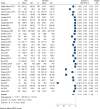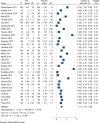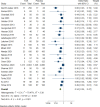Efficacy and safety of tranexamic acid in prevention of postpartum hemorrhage: a systematic review and meta-analysis of 18,649 patients
- PMID: 38001439
- PMCID: PMC10668444
- DOI: 10.1186/s12884-023-06100-8
Efficacy and safety of tranexamic acid in prevention of postpartum hemorrhage: a systematic review and meta-analysis of 18,649 patients
Abstract
Background: In this meta-analysis, we aimed to update the clinical evidence regarding the efficacy and safety of TXA in the prevention of PPH.
Methods: A literature search of PubMed, Scopus, Web of Science, Google Scholar, and Cochrane Library from inception until December 2022 was conducted. We included randomized controlled trials (RCTs) comparing TXA with a placebo among pregnant women. All relevant outcomes, such as total blood loss, the occurrence of nausea and/or vomiting, and changes in hemoglobin, were combined as odds ratios (OR) or mean differences (MD) in the meta-analysis models using STATA 17 MP.
Results: We included 59 RCTs (18,649 patients) in this meta-analysis. For cesarean birth, TXA was favored over the placebo in reducing total blood loss (MD= -2.11 mL, 95%CI [-3.09 to -1.14], P < 0.001), and occurrence of nausea or/and vomiting (OR = 1.36, 95%CI [1.07 to 1.74], P = 0.01). For vaginal birth, the prophylactic use of TXA was associated with lower total blood loss, and higher occurrence of nausea and/or vomiting (MD= -0.89 mL, 95%CI [-1.47 to -0.31], OR = 2.36, 95%CI [1.32 to 4.21], P = 0.02), respectively. However, there were no differences between the groups in changes in hemoglobin during vaginal birth (MD = 0.20 g/dl, 95%CI [-0.07 to 0.48], P = 0.15). The overall risk of bias among the included studies varies from low to high risk of bias using ROB-II tool for RCTs.
Conclusions: This meta-analysis suggested that TXA administration is effective among women undergoing cesarean birth or vaginal birth in lowering total blood loss and limiting the occurrence of PPH. Further clinical trials are recommended to test its efficacy on high-risk populations.
Keywords: Cesarean birth; Postpartum hemorrhage; Tranexamic acid; Vaginal birth.
© 2023. The Author(s).
Conflict of interest statement
The authors declare no competing interests.
Figures





Similar articles
-
Prophylactic Tranexamic Acid Prevents Postpartum Hemorrhage and Transfusions in Cesarean Deliveries: A Systematic Review and Meta-analysis.Am J Perinatol. 2024 May;41(S 01):e2254-e2268. doi: 10.1055/a-2109-3730. Epub 2023 Jun 13. Am J Perinatol. 2024. PMID: 37311543
-
Effect of preoperative prophylactic intravenous tranexamic acid on perioperative blood loss control in patients undergoing cesarean delivery: a systematic review and meta-analysis.BMC Pregnancy Childbirth. 2023 Jun 6;23(1):420. doi: 10.1186/s12884-023-05753-9. BMC Pregnancy Childbirth. 2023. PMID: 37280562 Free PMC article.
-
Tranexamic acid for the prevention of postpartum hemorrhage in women undergoing cesarean delivery: an updated meta-analysis.Am J Obstet Gynecol. 2022 Apr;226(4):510-523.e22. doi: 10.1016/j.ajog.2021.09.025. Epub 2021 Sep 25. Am J Obstet Gynecol. 2022. PMID: 34582795 Review.
-
Tranexamic acid for treatment of primary postpartum hemorrhage after vaginal delivery: a systematic review and meta-analysis of randomized controlled trials.J Matern Fetal Neonatal Med. 2020 Mar;33(5):869-874. doi: 10.1080/14767058.2018.1500544. Epub 2018 Sep 10. J Matern Fetal Neonatal Med. 2020. PMID: 30122082
-
Meta-analysis: the prophylactic use of tranexamic acid to reduce blood loss during caesarean delivery.Ir J Med Sci. 2025 Feb;194(1):311-322. doi: 10.1007/s11845-024-03834-y. Epub 2024 Dec 9. Ir J Med Sci. 2025. PMID: 39652279 Review.
Cited by
-
Duration time of labor progression for pregnant women of vaginal birth after cesarean in Hubei, China.Ir J Med Sci. 2024 Jun;193(3):1351-1358. doi: 10.1007/s11845-023-03600-6. Epub 2024 Jan 2. Ir J Med Sci. 2024. PMID: 38169049
-
The role of tranexamic acid in reducing postpartum hemorrhage in high-risk pregnancies.AJOG Glob Rep. 2025 Feb 15;5(1):100458. doi: 10.1016/j.xagr.2025.100458. eCollection 2025 Feb. AJOG Glob Rep. 2025. PMID: 40129858 Free PMC article. No abstract available.
-
Tranexamic acid for postpartum bleeding: a systematic review and individual patient data meta-analysis of randomised controlled trials.Lancet. 2024 Oct 26;404(10463):1657-1667. doi: 10.1016/S0140-6736(24)02102-0. Lancet. 2024. PMID: 39461793 Free PMC article.
-
Tranexamic acid for preventing postpartum haemorrhage after caesarean section.Cochrane Database Syst Rev. 2024 Nov 13;11(11):CD016278. doi: 10.1002/14651858.CD016278. Cochrane Database Syst Rev. 2024. PMID: 39535297 Free PMC article.
-
Tranexamic acid for preventing postpartum haemorrhage after vaginal birth.Cochrane Database Syst Rev. 2025 Jan 15;1(1):CD007872. doi: 10.1002/14651858.CD007872.pub4. Cochrane Database Syst Rev. 2025. PMID: 39812173 Free PMC article.
References
-
- Wormer KC, Jamil RT, Bryant SB. Acute postpartum hemorrhage. Treasure Island: StatPearls; 2022. - PubMed
-
- Sentilhes L, Vayssière C, Deneux-Tharaux C, Aya AG, Bayoumeu F, Bonnet M-P, et al. Postpartum Hemorrhage: guidelines for clinical practice from the French College of Gynaecologists and obstetricians (CNGOF) Eur J Obstet Gynecol Reprod Biol. 2016;198:12–21. doi: 10.1016/j.ejogrb.2015.12.012. - DOI - PubMed
-
- Evensen A, Anderson JM, Fontaine P. Postpartum hemorrhage: prevention and treatment. Am Fam Physician. 2017;95(7):442–449. - PubMed
Publication types
MeSH terms
Substances
LinkOut - more resources
Full Text Sources

